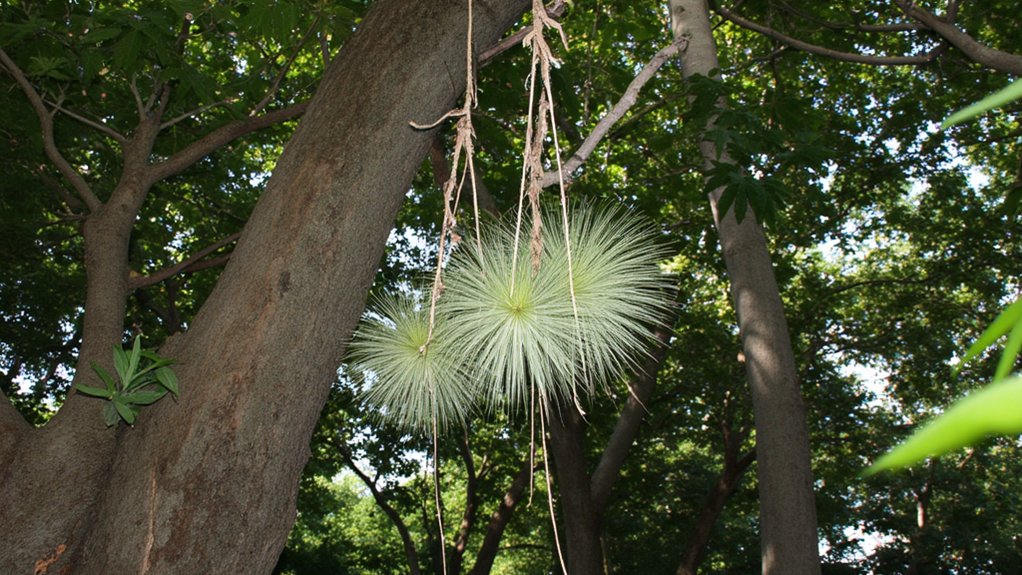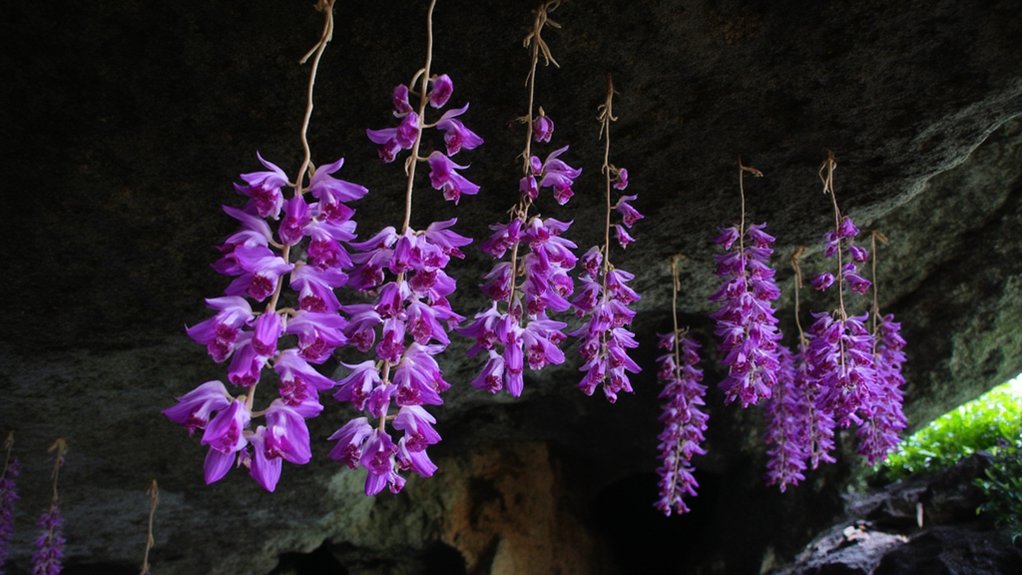You’d swear these plants were designed by nature’s mischief-makers when you first spot them growing completely upside down in the wild. While most vegetation reaches skyward, these botanical rebels have evolved to dangle from cliff faces and forest canopies, their stems and leaves pointing straight toward the ground. Their gravity-defying growth patterns aren’t just for show—they’ve developed sophisticated mechanisms that transform this seemingly awkward position into a survival advantage. The secrets behind their success involve some fascinating adaptations you’ll want to discover.
Contents
- 1 The Science Behind Inverted Plant Growth
- 2 Natural Habitat and Distribution
- 3 Notable Species of Upside-Down Plants
- 4 Adaptation Mechanisms and Survival Strategies
- 5 Benefits of Downward Growth Patterns
- 6 Cultivation and Care Requirements
- 7 Conservation Status and Environmental Threats
- 8 Horticultural Applications and Garden Design
The Science Behind Inverted Plant Growth

While plants naturally grow upward toward light sources, they possess remarkable adaptability that allows them to thrive in inverted positions. You’ll find that plants respond to gravity through specialized cells called statocytes, which contain dense starch granules that settle to the lowest point.
When you turn a plant upside down, these granules shift, triggering hormonal responses that redirect growth. The plant’s auxin hormones redistribute, causing stems to bend upward and roots to grow downward, regardless of the plant’s orientation. This process, called gravitropism, can take anywhere from a few hours to several days.
Natural Habitat and Distribution

Although upside-down growing plants might seem unusual, they’re found naturally in several regions across the globe. You’ll discover these gravity-defying species primarily in tropical rainforests, where epiphytes like Tillandsia grow inverted from tree branches and rock faces.
In Australia’s eucalyptus forests, you’ll find the rock orchid (Thelychiton speciosus) hanging from cliff edges, while in Southeast Asia’s limestone caves, Gesneriaceae species dangle from cave ceilings. Central and South America host numerous pendant ferns, including the chain fern (Woodwardia radicans), which you can spot cascading down humid mountainsides at elevations between 1,000-2,500 meters.
Notable Species of Upside-Down Plants

Several fascinating species have adapted to grow upside down in their natural environments. You’ll find the Australian Rock Orchid (Thelychiton speciosus) hanging from cliff faces, with its roots firmly anchored in rock crevices while its stems and flowers cascade downward.
The Sky Plant (Tillandsia ionantha) doesn’t need soil at all – it clings to tree branches or power lines with its roots facing upward. In cloud forests, you’ll spot the remarkable Dancing Lady Orchid (Oncidium flexuosum), which grows inverted on tree limbs, its delicate yellow blooms swaying in the breeze like tiny performers.
The most striking example is Ficus pumila var. awkeotsang, which develops its fruit pods pointing skyward.
Adaptation Mechanisms and Survival Strategies
Plants that grow upside down have evolved remarkable mechanisms to thrive in their inverted state. You’ll find these adaptations center around modified vascular tissues, where specialized cells transport water and nutrients against gravity’s pull. Many species develop thicker cell walls and enhanced xylem vessels to maintain proper fluid flow.
Their leaves show impressive adaptations too. You’ll notice they often twist 180 degrees at the base, repositioning their surfaces to capture sunlight efficiently. These plants also produce stronger attachment points and modified root systems that anchor firmly to their elevated growing spots, preventing accidental drops while maximizing nutrient absorption.
Benefits of Downward Growth Patterns
Growing downward offers surprising advantages you won’t find in traditional upright gardening. You’ll notice your plants require less water, as gravity helps distribute moisture more efficiently through the root system. This natural irrigation can reduce your watering needs by up to 30%.
In tight spaces, downward-growing plants maximize vertical real estate while keeping fruits and flowers at eye level. You’ll find harvesting easier, with no bending or reaching required. Plus, suspended growth naturally protects your crops from soil-borne diseases and ground pests.
Your plants will develop stronger stems too, as they work against gravity, resulting in more robust growth and increased fruit production.
Cultivation and Care Requirements
While traditional gardening skills transfer well, successful upside-down cultivation requires some specialized knowledge and techniques. You’ll need to select containers with sturdy hanging mechanisms and proper drainage holes positioned at the top of your growing space.
Start by creating a balanced potting mix that’s lighter than standard soil – combine one part perlite, one part vermiculite, and two parts peat moss. You’ll want to water more frequently than conventional plants, typically every 2-3 days, as gravity causes faster drainage.
Monitor your plants’ growth closely, and trim any stems that grow upward rather than cascading down. Maintain temperatures between 65-80°F for best results.
Conservation Status and Environmental Threats
Although upside-down gardening doesn’t face traditional conservation threats, several environmental challenges can affect these innovative growing systems. You’ll need to watch for issues like wind damage, excessive heat exposure, and water runoff that can stress your inverted plants.
Climate change poses additional risks, with unpredictable weather patterns affecting growing seasons and plant stability. You’re likely to encounter more frequent extreme temperature swings, which can damage roots exposed to the elements in suspended containers.
Urban pollution and airborne contaminants can also impact your upside-down plants, especially in city environments where they’re often grown on balconies or rooftop gardens.
Horticultural Applications and Garden Design
The art of upside-down gardening opens up exciting possibilities for creative garden design. You’ll find that hanging baskets, inverted planters, and vertical wall systems can transform ordinary spaces into gravity-defying displays.
For best results, start with lightweight containers that have sturdy mounting mechanisms and proper drainage. You’ll need to select plants with flexible stems and compact growth habits, such as cherry tomatoes, peppers, or trailing petunias.
When designing your layout, consider the mature size of each plant and space them 12-18 inches apart. Remember to position your upside-down displays where they’ll receive adequate sunlight and you can easily reach them for watering.
